For the ‘forever’ format, a format that never rotates, change is a constant in Vintage. Change in Vintage is precipitated by one of two events: new printings or changes to the banned and restricted list.
New printings bring tremendous change to Vintage, which may seem surprising for such a format with such an enormous card pool. Yet, virtually every new set brings at least a Vintage playable, and usually more than one set makes a major impact on the format per year. Last year alone, Painter’s Servant, Reveillark, and Tezzeret the Seeker were three major printings with format wide reverberations. Also significant were cards like Overlord Hellkite, Ethersworn Canonist, and Ad Nauseam, which have made their presence known, although their impact hasn’t been quite as broad or profound.
Unrestrictions are similar to new printings. They open up design space and provide new deck building options. Since the card is being removed from the restricted list, it by definition vintage ‘playable,’ or it never would have been on the restricted list in the first place.
Restrictions are the most significant change that occurs to the Vintage format since the problem being addressed by the restriction is, by definition, format defining. It’s a fundamental change to the system, as opposed to merely a new input, which may or may not produce system wide change. New printings tend to change the system in stages. The new or different deck enters the metagame, and the metagame reacts or adapts. With restrictions, the extant metagame is, in some degree, thrown out.
For that reason, restrictions create the greatest sense of openness and of possibility. Last year at the time, the Vintage metagame was thrown open and it took several months for the field to congeal into a clear pattern.
My sense is that players are excited about NuVintage, and not simply because of the openness of the field in these early months, but because of the expectation of greater metagame balance in the long run. Last year’s restrictions were the megaton variant of ‘whack-a-mole.’ This time around, the DCI was playing ‘House M.D.’ with the Vintage format, and was just as smart. I also think many players were underestimating the impact of the restriction of Thirst For Knowledge. I think there are reasons for that. Thirst was rarely in the discussion as a possible restriction, and it was almost never described as ‘a problem.’ Time Vault and Mana Drain got most of the bad press. Certain cards get all of the attention.
In a sense, Thirst is the opposite of Gush. Many of the problems of the metagame from June, 2007 through June, 2008 were attributed to Gush, when the problem wasn’t Gush, it was the Gush-bond engine. Gush didn’t need to be restricted to solve that problem (just Scroll and Brainstorm would have sufficed), yet that’s not how most people think about that era. In fact, that era is often described as the second “Gush era” of Vintage. Gush was the salient feature of the format at the time, but it wasn’t the problem. Merchant Scroll was (and had been for the year before that as well.) That’s one of the reasons it’s so difficult to persuade people that Gush is a safe unrestrict, because people attribute that era’s problems to Gush. Whenever I propose unrestricting Gush or Flash it’s difficult to get people to separate their perception of those cards from how they remember them at a time when you could use them with Merchant Scroll, Brainstorm, and Ponder.
Gush gets the much of the blame for Merchant Scroll, Brainstorm and Ponder, and Time Vault tends to get a disproportionate amount of the blame for this era’s problems, ignoring or downplaying the role that Drain and Thirst have played. That’s a big reason why I think that people are underestimating the impact of the restriction of Thirst.
Last Friday, Tom LaPille, speaking for Wizards, explained the DCI’s decisions to restrict Thirst for Knowledge and unrestrict Crop Rotation and company. There are a few things worth noting.
First, the DCI, for the first time, elaborated on a vision for the restricted list of keeping that list as short as possible while maintaining the health and diversity of the format. Although DCI actions over the last couple of years have followed a pattern of unrestricting cards that need not be restricted, this is the first time that the DCI has described its vision of the restricted list in those terms.
For many, the restricted list was understood as a repository, a Hall of Infamy, for Magic’s most broken cards. As Tom described:
I began playing Magic in 1997. Back then, Vintage followed a pattern: every few years a massively powerful deck would appear, one or more cards would be restricted because of it, and the process would repeat. Cards were never removed from the restricted list, so the list kept growing and growing. I assumed that the logic was that if a card was powerful enough to make it onto the list, there was no way it would ever be safe to let it off.
Tom was not alone. Whenever someone proposed an unrestriction because the card would no longer be very good, it was often said that ‘if the card’s unrestriction wouldn’t matter, then it also doesn’t matter if it stays on the restricted list or not.’ This became a rationale for inaction. The DCI has now officially and unequivocally rejected that argument. As Tom said:
We are excited about the shrinking restricted list. On a very basic level, we like it when Magic players can play with their cards. We currently have the shortest restricted list that we’ve had since 1999, and thanks to the ever-increasing number of Magic cards in existence, we also have by far the lowest fraction of Vintage-legal cards on the restricted list.
Tom gets it. Vintage players enjoy having access to all of their cards, whether they are good or not. Vintage players feel that the principle is important.
To illustrate this, Tom pointed to the September, 1999 restrictions, the largest wave of restrictions since the origin of the format, sending 18 cards to the restricted list. The DCI went way overboard in restricting cards, and as a result, half of those cards are currently unrestricted today.
But just as importantly, the question is not just whether a card is too good or unplayable. There are degrees in between. Cards like Mind Twist or Hurkyl’s Recall are playable, but they aren’t a real danger to the format. A decade ago, it was felt that cards should not be unrestricted, even when the danger is no longer real. No longer.
As Tom wrote:
[B]ecause unrestricting cards was not something that happened often, all eighteen of these cards stayed on the restricted list for many years even after they no longer posed a danger.
In the modern era, we have a more nuanced understanding of the Vintage metagame.
Third, the DCI reiterated its framework for managing diversity in the Vintage format. Specifically, they reiterated the point that what they are seeking is some degree of balance between blue-heavy Force of Will decks, Mishra’s Workshop decks, Dark Ritual decks, and Bazaar of Baghdad decks. As Tom said:
The four tournament Vintage archetypes that we have identified revolve around four cards: Dark Ritual, Force of Will, Bazaar of Baghdad, and Mishra’s Workshop. In the current Vintage metagame, Mana Drain is by far the most powerful unrestricted blue card other than Force of Will, so almost all of the Force of Will decks are also Mana Drain decks. In order to keep a diverse metagame, all four of these archetypes need to have a real shot at winning a match and the archetypes need to stay distinct.
This framework for thinking about Vintage was first articulated by Tom a few months ago, when he attempted to again explain the changes to the restricted list last year. Since this is their operational framework, I will continue to track Vintage data by these engines to see if these restrictions will produce the desired outcome.
I personally think that “Force of Will” as a category is too broad. One reason is that Dark Ritual decks often use Force of Wills, and Workshop and Bazaar decks use them as well, depending on the deck. Another problem is that Force of Will decks encompass such a tremendous amount of variety. There is a meaningful difference between Mana Drain decks that run Force of Will and Fishy Null Rod-based decks that run Force of Will, to take one comparison. Also, I am not sure that it is worthwhile or even desirable to try and create balance between “Force of Will” decks and non-Force of Will decks. Force of Will is so omnipresent that it often makes up 50% or more of Top 8s. It’s not an engine; it’s a tool. You could restrict every other Blue card in Vintage and you would still have tremendous numbers of Force of Wills in Vintage top 8s. I think the more important point of comparison is between Mana Drain decks and the three other engines mentioned.
Viewing the format through the Force of Will, et. al. framework can lead to bad decisions. For example, Flash decks and Tezzeret decks were very different both tactically and strategically. They were totally different decks. But to subsume them under the label “Force of Will” decks makes the error of treating them the same. Similarly, Gush decks are not the same deck as Mana Drain based decks. They occupied different positions on the metagame star, with different roles and weaknesses. Treating them as if they were the same can result in restrictions like those last year that backfire.
Despite this minor quibble, the DCI appears, this time, to be attentive to the fact that it was Mana Drain decks, not ‘Force of Will’ decks, that were the problem. Throughout the article Tom justifies the unrestrictions with comments along these lines: The net effect of the Vintage restricted list changes will be to weaken Mana Drain decks and strengthen other decks in comparison. Each unrestriction is explained in that it will not help Drain decks, which is 100% the correct framework to be using.
Before this announcement many Vintage players were at a loss to figure out what could be done to fix the format. Most players knew that something needed to happen, but they weren’t sure what. Of all of the possible solutions, I think the DCI has probably chosen the best mix, a surgical strike: a targeted restriction and careful, but targeted unrestrictions. The unrestrictions are designed to have an impact, but one that will create minimal unintended consequences.
Interestingly, the restricted list is, now more than ever, blue. Blue has more restricted cards than all of the other colors combined.
Blue (16):
* Ancestral Recall
* Time Walk
* Timetwister
* Mind’s Desire
* Tinker
* Windfall
* Gifts Ungiven
* Fact Or Fiction
* Brainstorm
* Gush
* Ponder
* Mystical Tutor
* Merchant Scroll
* Frantic Search
* Thirst For Knowledge
* Flash
Black (7):
* Yawgmoth’s Will
* Yawgmoth’s Bargain
* Necropotence
* Demonic Tutor
* Vampiric Tutor
* Imperial Seal
* Demonic Consultation
Red (2):
* Burning Wish
* Wheel Of Fortune
Green (3):
* Fastbond
* Channel
* Regrowth
White (1):
* Balance
Given the path that they’ve taken, of restricting more Blue cards to deal with Drain dominance rather than unrestrict certain Blue spells, such as Gush and Flash, the format is going to look increasingly normal if you aren’t playing a Blue deck. Aside from Blue draw spells, everything else, in particular lower tier Tutors and mana accelerants that aren’t being abused by Drain decks, is being unrestricted.
That means that the older ways of looking at the restricted list: tutors, acceleration, sources of card advantage, and so on, is wrong and antiquated. If you are a mana accelerant or a tutor, but you aren’t used by blue, you are unrestricted or likely unrestrictable. But if you are abused by a Force of Will deck, you are still going to be restricted. That explains Chrome Mox, Grim Monolith, Mox Diamond, Dark Ritual, Mishra’s Workshop, and so on. That also explains why Bazaar of Baghdad is unrestricted, but Library of Alexandria is not. It explains why Crop Rotation, Enlightened Tutor, and Entomb can be unrestricted, but Merchant Scroll is not. People used to focus on comparing existing cards with cards on the restricted list as a reason to restrict, or not. That point of comparison is no longer valid.
As I said, the restricted list is now, more than ever, Blue, or about cards that Blue decks abuse. Four of the restricted Black spells are specifically spells that are abused by Drain decks (Demonic Tutor, Vampric Tutor, Imperial Seal, and Yawgmoth’s Will. Two of the remaining three are specifically spells abused by Dark Ritual decks. The remaining restricted Black spell is Demonic Consultation.
For the reasons I just described, I suspect, for the first time ever, that Demonic Consultation might be a good candidate for unrestriction. The ‘Blue’ Mana Drain deck is a deck of restricted cards: Ancestral Recall, Tinker, Yawgmoth’s Will, Time Vault, etc. Demonic Consultation would have no place in such a deck (although Painter could perhaps use it), it would not contribute to the problem of helping the Drain Time Vault/Yawg Will/Tinker decks. The other ‘blue deck’, Dark Ritual based storm combo, like TPS, which uses most of the restricted blue spells would not be able to abuse Consult for the same reason. The Dark Ritual decks that don’t run Force of Will, like Ad Nauseam or GWSx, might be able to use Consult, but that wouldn’t help either the “Force of Will” decks, to use the DCI’s framework, or “Drain decks.” On the other hand, Consult could help Dark Rituals, Shops, and Bazaar decks, precisely those archetypes that the DCI is trying to help ‘catch up,’ as Tom put it. It would also potentially help aggro decks which use Null Rod and fast disruption like Duress.
Those are questions for another day. For now, I think we have a much clearer vision of the restricted list, what it’s about and what we can expect from the DCI going forward. The goals, so to speak, are much clearer. Restricted list policy is no longer about restricting aces, but clearly about helping keep the dominant Drain deck in check and fostering format diversity. And that goes for unrestrictions as well as restrictions. Unrestrictions are now clearly a policy tool, not simply a begrudging house cleaning.
Vintage players have reason to be optimistic. While some believe that these restrictions won’t change the pattern of Tezzeret’s dominance, I think that it will. I believe that the degree of dominance won’t be quite as striking in the future. But what makes these changes so inspiring is that the DCI has laid the groundwork for future tweaks just in case more needs to be done. These changes have made it much clearer what the restricted list is really about, and therefore have made it much more obvious which future unrestrictions could potentially be used in case things do not improve, such as Demonic Consultation.
The StarCityGames.com $5000 Legacy Open
One hundred and eighty-seven players showed up for the inaugural Legacy $5K tournament in Boston a week ago Sunday. I have decklists! Unfortunately (and I’ll make sure we correct that for next time), SCG did not give me swiss standings.
I looked at how Adrian Sullivan broke down earlier SCG $5Ks, and I like his methodology for graphing *top* penetration. He shows the field by archetype, and then shows the percentage of that archetype that made Top 64, Top 32, Top 16, and Top 8. While I think that is important and useful, I think the better way to illustrate archetypes is to do what I did for the Watebury a few weeks ago and show the distribution of the archetype throughout the field as a whole. I discovered that archetypes tend to cluster in certain regions of the field. These peaks are very revealing, and I think they are an underutilized tool for metagame analysis (yay, pioneering field analysis!). In the Vintage context, if we had just looked at the breakdown using top penetration, we would have missed the very important ways in which various archetypes clustered, as this composite line graph shows:
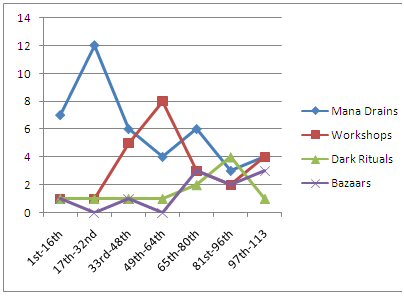
Drains tended to cluster in the top, Workshops in the middle, and Rituals and Bazaar of Baghdad decks near the bottom. The individual line charts, which I set out in the article, were very revealing. Take a look at these two:
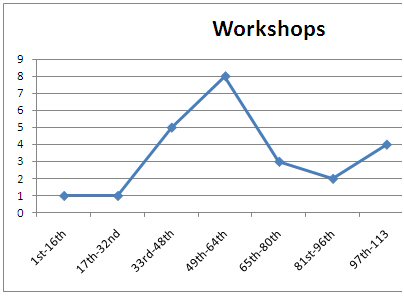
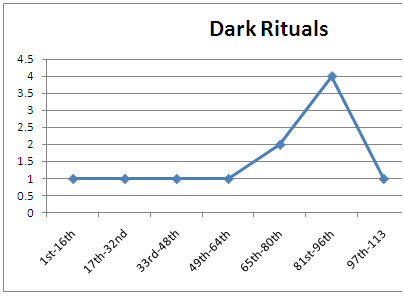
These are not random patterns. This is very insightful information that I’d like to share for the Legacy field. For instance, it would be useful to see where Counterbalance decks or Goblin decks tend to peak in the field. If SCG is able to get that information to me, I will graph it for you in the future.
As it stands, I can only show you Top 16 penetration and the field breakdown by archetype.
22 Fish
– 14 Mono blue 14
– 5 With Goyf (5th)
– 3 Dreadtill Hybrid 3
20 CounterTop Goyf
– 10 UGBW
— 4 Intuition Loam Control variants (It’s the Fear) (10th place)
— 6 Aggro-Control (Next Level Blue style)
– 5 UGRB
– 2 UBG
– 2 UGRW
– 1 UGW
18 Red Base Zoo
– 16 RGW (4th, 14th)
– 1 R/G
– 1 RGB
11 U/G/R Threshold (Canadian Threshold) (2nd,11th 16th)
10 Goblins
– 1 Food Chain
– 3 R/G/B (13th)
– 3 G/R
– 2 R/B
– 1 R/B/W
10 Tendrils Storm Combo (all ran at least 1 Ad Nauseam) (7th)
8 Goyf Sligh
8 G/B Goyf/Tombstalker (Eva Green)
7 Dragon Stompy
7 Dreadtill (1st, 3rd)
– 5 Ugr
– 2 Ur
5 Affinity
5 Landstill
– 4Uwb
– 1Ugrw
4 Dredge
4 Survival variants (12th)
4 Burn (9th)
3 Scepter-Chant
3 Elves!
2 Enchantress
2 UW Canadian Countertop Control
2 Stasis
2 Ugr Painter
2 Suicide Black
2 The Rock
2 Aggro Loam (15th)
1 Pox
1 Aluren
1 Slivers
1 Belcher
1 UBG Coatl Counter-Top
1 Mono White Stax
1 Mono Black Stax
1 W/B Aggro-Control
1 Mono Green Natural Order
1 Sea Stompy
1 43 Land.dec
1 WGB Zoo
1 BG Zoo
1 Wizards w/Goyf
1 ‘Wumpus World’ (Blood Moon Zooish)
1 “Bant of the Money” (Doran Zoo)
1 “Night of the Living Dead” (mono black zombies)
1 Highlander deck
1 “Guilty minds” (guiltfeeder deck)
1 W/G Natural Order deck
1 UW Aggro Control
1 Planeswalker Control (6th)
1 Burning Goyf Control (8th)
Some of the decks listed in the Top 16 are misnamed, and I have corrected for that here. For example, Eli Kassis did not play Counter-Top Goyf. He didn’t even have any Counterbalances. Also, Alix Hatfield played Zoo, not Goyf Sligh.
First of all, let me say that I am astonished by the sheer quantity of Tarmogoyf in the field. It was in so many decks. Conservatively, I estimate that it showed up in about eighty-six decks! That’s about 45% of the field! It was in Dreadtill, Countertop decks, Canadian Threshold, Eva Green, Goyf sligh, Zoo, the Rock, Fish, and on and on. That’s simply incredible. I had no idea that Goyf was that dominant in this format.
With that out of the way, there is a big problem in representing the various Counter-Top goyf decks. There are so many variants, and they are often very different. For example, almost all of the Dreadtill decks ran Goyf and Counterbalance, yet I’ve set them out as different. It’s not clear why. It’s also important that legacy, as a format, find ways to distinguish between them in a way that is comprehensible by those who aren’t embedded in the format. The good news is that the vast majority of these (non-Dreadtill) decks clustered into two color combinations: U/G/R/B and U/G/W/B. That makes them more amenable to analysis. Then, as you can see, I broke them into two groups: whether they were running the Intuition/Loam engine, which suggested a more controlling version, or whether they were more like traditional Next Level Blue decks. Gerry Thompson and Steve Sadin both ran the Loam versions rather than the Nassif/LSV variants. Then, the UGBR versions seemed to be drawn from Andy Probasco list. They ran lots of Shackles and Sowers. However, two of those five also ran four Dark Confidant, which Andy did not run. I think by my breakdown I’ve managed to capture the differences between these variants.
Graphically, here’s the field again, but with Top 16 penetration visible:
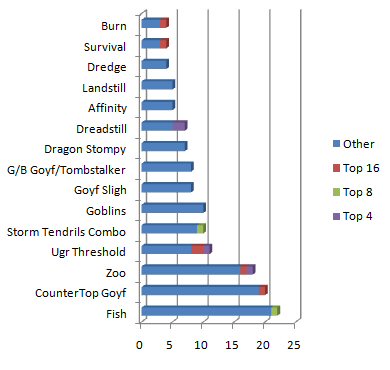
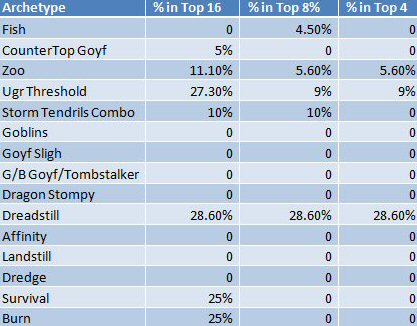
This table shows Top 16 penetration by % of total in the field.
From this, it’s clear that two archetypes performed better than everything else. Ugr Threshold (aka Canadian Threshold) was one of the best performers, with three representatives in the top 16. However, it’s proportion fell as it moved into the top 8 and final four.
By far the best performer of the major archetypes was Dreadtill. In fact, this chart undercounts its performance, since two of the seven Dreadtill decks were UG. Of the UGr versions, a full 40% made top 4! That’s an incredible accomplishment. Statistically speaking, UGr Dreadtill wiped the floor with the entire format. Dreadtill made up 25% of the top 8 and 50% of the top 4.
When you think about it, it’s not that surprising. The results of Grand Prix Chicago suggested that the way to go with four color counter-top Goyf was the Sower/Shackles versions that Nassif and LSV ran. Shackles is bad against Dreadnaught and Factory, and Sower is easily stopped with the red Dreadtill splash of Fire/Ice, Lightning Bolt, and the like. Probasco’s list and variants modeled after it probably have an ever worse time.
Also, and this is important, the amount of Fish in the field must have had an impact. Fish was by far the most popular archetype, and it must have created quite a bit of a headache for Counterbalance pilots. On the other side of the metagame was a huge number of Goyf Sligh and Zoo decks, which try to overwhelm the 4c Counter-Top Goyf decks.
This metagame appears to be a direct outgrowth of the metagame we witnessed in Chicago. The shifts are quite visible and logical. It will be interesting to see where the field goes from here.
I received requests to post some decklists.
According to some Sourcers, this deck got 17th place:
UR Dreadtill
Rodney Hannigan
17th Place at SCG $5k Legacy
4 Phryexian Dreadnaught
3 Trinket Mage
4 Brainstorm
3 Daze
4 Force of Will
3 Spell Snare
4 stifle
2 Trickbind
3 Counterbalance
4 Standstill
2 Sensei’s Divining Top
2 Engineered Explosives
3 Flooded Strand
6 Island
4 Mishra’s Factory
3 Polluted Delta
2 Volcanic Island
3 Wasteland
Sideboard:
3 Red Elemental Blast
1 Pyroblast
2 Echoing Truth
1 Sower of Temptation
3 Tormod’s Crypt
3 Pyroclasm
1 Pithing Needle
1 Crucible of Worlds
This deck falling just outside of the top 16 should reinforce our conclusion that Dreadtill was the best deck in this metagame.
Goyf Sligh
Michael Farrell
18th Place
1 Barbarian Ring
4 Tiaga
7 Mountain
4 Bloodstained Mire
4 Wooded Foothills
4 Tarmogoyf
4 Mogg Fanatic
4 Figure of Destiny
4 Grim Lavamancer
3 Keldon Marauders
2 Vexing Shusher
3 Fireblast
4 Price of Progress
4 Lightning Bolt
4 Chain Lightning
4 Magma Jet
Sideboard:
2 Red Elemental Blast
1 Pyroblast
3 Tormod’s Crypt
3 Krosan Grip
2 Pithing Needle
2 Shattering Spree
2 Volcanic Fallout
Merfolk/Dreadtill Hybrid
Rob Rogers
24th Place
4 Aether Vial
4 Phyrexian Dreadnaught
4 Cursecatcher
4 Silvergil Adept
4 Lord of Atlantis
4 Force of Will
3 Merrow Reejerey
4 Daze
4 Standstill
4 Stifle
1 Trickbind
4 Mutavault
4 Wasteland
12 Island
Sideboard:
3 Submerge
3 Relic of Progenitus
3 Annul
2 Spell Snare
1 Trickbind
3 Chill
Ugo Rivard and his partner Ian Fournier, French Canadians, ran this deck;
“Boxborough”
Ugo Rivard
5 Plains
8 Island
1 Tundra
4 Flooded Strand
4 Polluted Delta
3 Pithing Needle
4 Sensei’s Divining Top
3 Brainstorm
4 Counterbalance
4 Meddling Mage
1 Alexi’s Cloak
4 Peacekeeper
3 Jace Beleren
3 Cunning Wish
2 Magus of the Moat
3 Misdirection
4 Force of Will
Sideboard:
1 Blue Elemental Blast
1 Hydroblast
1 Path to Exile
1 Brain Freeze
1 Dismantling Blow
1 Pulse of the Fields
3 Swords to Plowshares
3 Ajani Goldmane
Ugo Rivard is a multiple SCG P9 Champion, and a skilled deck builder. I thought some Legacy players might find this French Canadian deck of interest. I don’t know where he placed since I don’t have swiss standings.
Here is another interesting deck, piloted by Matt Elias:
4 Painter’s Servant
3 Grindstone
3 Sensei’s Divining Top
2 Engineered Explosives
2 Phyrexian Dreadnaught
4 Brainstorm
4 Stifle
3 Daze
3 Fact or Fiction
4 Force of Will
3 Red Elemental Blast
4 Trinket Mage
3 Wasteland
4 Ancient Tomb
1 Island
1 Seat of the Synod
4 Volcanic Island
4 Flooded Strand
2 Polluted Delta
1 Academy Ruins
1 Tropical Island
Sideboard:
4 Propaganda
2 Relic of Progenitus
2 Tormod’s Crypt
2 Echoing Truth
1 Red Elemental Blast
1 Pyroblast
3 Counterbalance
Until next time…
P.S. Props to Robert Seder for playing my suggested deck. How did you end up?

